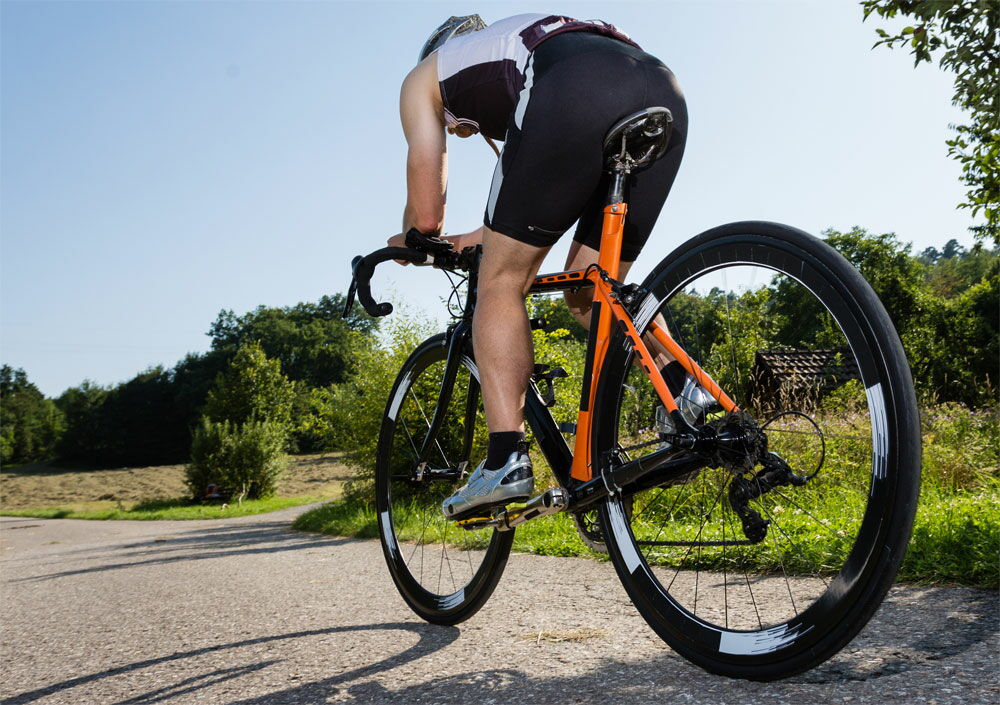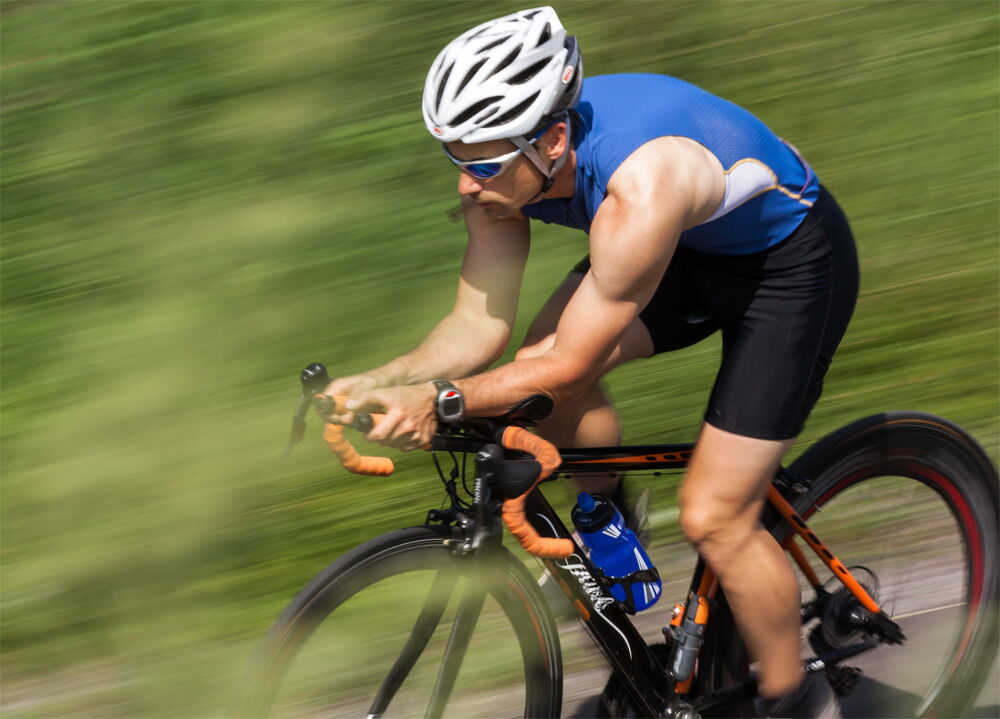As anticipated in the previous introductory article Integration and nutrition in cycling, we will now look at a work-related protocol for improving power.
Adjusting the bicycle
We'll assume that your riding position is optimal, you've definitely made a leap biomechanically, or you have made the necessary measurements before purchasing. Many cycle shops have a dedicated area for saddle adjustments.
If you have not yet done so, we strongly encourage you to see to this. Most disorders are the result of poor "saddle adjustments", particularly after you've decided to take cycling more seriously, when stress on the joints of the lower limbs becomes significant.
Think about it: 90/100 pedal movements per minute for 2/3 hours, whilst your body is kept in a non-physiological position. DEVASTATING! If it went on for months, the damage is done!

Imagine: running in shoes that are a size too small for you; perhaps in the first few minutes you would have no problems - there would definitely be some discomfort, but it might be tolerable. Would you try to complete a marathon in such shoes?
Your feet would be completely destroyed! Don't believe it?
The same thing happens to your joints, if you end up with a tubular condropathy, or tendon inflammation, you say goodbye to the bike for a while ...
Many orthopaedic and physical therapists recommend cycling as a sport / functional method for the post-operative recovery of ligaments, menisci, etc., but also as a way of building up the muscles after various types of leg injuries. So your riding position should be reviewed by a professional in the field, then you can ... GET PEDALLING!!!
As the old adage says, prevention is better than cure ...
Basic settings
These are crucial:
- Optimal saddle height (made with inside leg measurement)
- Pedalling length depending on femur length
- The right size of frame, to avoid excessive kyphosis
- Assess the position of the "saddle" well
Once the necessary measurements have been made, a good athlete / cyclist will know whether the new riding position or pedalling characteristics will work straight away, novices however, will just have to trust the shop assistant or biomechanic.
DIY is fine if you only use your bike to go out for a drink of coffee ... but if you consider yourself to a real cyclist and value your joints, a few pounds couldn't be better invested.
Heart rate monitors
One final useful tip is to buy a tool that can record all of the data connected to your effort: heart rate, speed, cadence, and even GPS.
There are a huge range of products on sale, from the excellent GARMIN and POLAR, to entry level products you can find everything for a few pounds. It is interesting during the season to compare and assess your data and check for any improvements.

Heart rate while training
With the help of a good heart rate monitor, you can calculate your maximum heart rate (MHR), the most commonly used commercial formulas are 220 - age, so, if you are 30 years old, your MHR will be: 220 - 30 = 190 bpm (beats per minute). That's why we have to calculate the various working heart rates that are useful for our workout program.
For the time being we'll just calculate 3:
- BASELINE/SLOW no more than 75% of your MHR
- MEDIUM / FAST from 75% and no more than 90% of your MHR
- THRESHOLD over 90% of MHR
Potentiation
Very important phase of improvement, we need to increase the capacity of our engine.
The energy metabolism that stimulates our body to increase the transverse diameter of our muscles (muscle mass increase) is "anaerobic lactic acid metabolism", that is, where a massive strain lasts for over 10 seconds until muscular exhaustion (which is obtained in 40 seconds after beginning to exercise).
However, even exercise performed using non lactic acid anaerobic metabolism (exercise ceiling under 10 seconds) does stimulate an increase in muscle mass, but to a lesser extent. By contrast, cycling endurance activities, for instance, "classic" cycling for 2 hours in an aerobic regime, only produces an increase in muscle tone with a very modest hypertrophic input.
PROTOCOL - ONE - STRENGTH
Climbing Power Resistance (SFR)
This type of work is performed with gradients ranging from 4/8% using a fairly hard ratio, 70/80 rpm (pedal revolutions per minute), you may find your climb a bit of a trial.
If you live in an area where the first hill you can find is 2 hours by car, you can opt for a similar workout on the flat, but the Resistance Force will be provided by the gear ratio.
53/15 might be one you could use.
Please note: If during the SFR sessions you experience joint pain, specifically in the knee, end the session immediately. Its best to understand the cause of such pains before continuing with SFR. Double check your position on the bike and then try again.
Fundamental warm up: 30 minutes at 90 RPM, to be performed before every SFR session
Recommended agility: 30 minutes at 90/100 RPM, executed after each session of SFR
1st week
Monday - training for 60 '/ 90' at slow / long 80/100 rpm
Tuesday - SFR 5 x 2 'recovery 3' uphill, Fc agile ratio 90/100 rpm - Fc medium / fast,
Wednesday - recovery, recommended sauna or Turkish bath
Thursday - training for 60 '/ 90' tat slow / long 80/100 rpm
Friday - SFR 5 x 2 ' recovery 3' uphill, agile ratio
Saturday and Sunday - free exercise with a group, you can also choose to do only one day, and use the other for good recovery
2nd week
Monday - training for 60 '/ 90' at slow / long 80/100 rpm
Tuesday - SFR 5 x 3 ' recovery 3' uphill, agile - Fc ratio medium / fast
Wednesday - recovery, recommended sauna or Turkish bath
Thursday - training for 60 '/ 90' at slow / long 80/100 rpm
Friday - SFR 5 x 3 ' recovery 3' uphill, agile ratio
Saturdays and Sundays - as above
3rd week
Monday - training for 60 '/ 90' at a slow / long 80/100 rpm
Tuesday - SFR 5 x 3 'recovery 2' uphill, agile - Fc ratio to medium / fast
Wednesday - recovery, recommended sauna or Turkish bath
Thursday - training of 60 '/ 90' at slow / long 80/100 rpm
Friday - SFR 5 x 3 'recovery 2' uphill, agile ratio
Saturday and Sunday - as above
4th week
Monday - training for 60 '/ 90' at slow / long 80/100 rpm
Tuesday - SFR 6 x 3 'recovery 2' uphill, Fc agile ratio - medium / fast
Wednesday - recovery, recommended sauna or Turkish bath
Thursday - training for 60 '/ 90' at slow / long 80/100 rpm
Friday - SFR 6 x 3 ' recovery 2' uphill, agile ratio
Saturday and Sunday - as above
5th week
Monday - training for 60 '/ 90' at slow / long 80/100 rpm
Tuesday - SFR 5 x 4 ' recovery 3' uphill, agile - Fc ratio medium / fast
Wednesday - recovery, recommended sauna or Turkish bath
Thursday - training for 60 '/ 90' at slow / long 80/100 rpm
Friday - SFR 5 x 4 ' recovery 3' uphill, agile ratio
Saturday and Sunday - during the workout, go over 90% of your MHR for at least 1 '
6th week
Monday - training for 60 '/ 90' at slow / long 80/100 rpm
Tuesday - SFR 6 x 3 'recovery 2' uphill, Fc agile ratio - medium / fast
Wednesday - recovery, recommended sauna or Turkish bath
Thursday - training for 60 '/ 90' at slow / long 80/100 rpm
Friday - SFR 6 x 3 ' recovery 2' uphill, agile ratio
Saturday and Sunday - go at threshold for at least 2'
7th week
Monday - training for 60 '/ 90' at slow / long 80/100 rpm
Tuesday - SFR 7 x 4 ' recovery 3' uphill, agile - Fc ratio medium / fast
Wednesday - recovery, recommended sauna or Turkish bath
Thursday - training for 60 '/ 90' at slow / long 80/100 rpm
Friday - SFR 7 x 4 ' recovery 3' uphill, agile ratio
Saturday and Sunday - during the workout, go at threshold for at least 3 '
8th week
Monday - training for 60 '/ 90' at slow / long 80/100 rpm
Tuesday - SFR 8 x 4 ' recovery 3' uphill, agile - Fc ratio medium / fast
Wednesday - recovery, recommended sauna or Turkish bath
Thursday - training for 60 '/ 90' at slow / long 80/100 rpm
Friday - SFR 8 x 4 'recovery 3' uphill, agile ratio
Saturday and Sunday - during workout, go at threshold for at least 5 '
9th week
Functionally drained, no more than the 3 medium workouts
Conclusions
The problem of the overwhelming majority of amateurs is not the ability / adequacy of the training workload, but the insufficient value they place on RECOVERY.
The increase in intensity and volume management is proportional to recovery.
So in many cases, not going out cycling, returns more in physical terms that going for a ride when you'retired and don't really want to. Always listen to the signals / stimuli your body gives you.
Good luck with your training!
